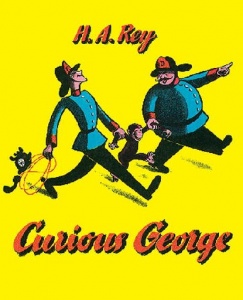H. A. Rey
Listen to the Recess! Clip
| Author | John Cech |
| Air Date | 9/16/1999 |

H. A. Rey Transcript
Hans Augusto Rey, better known as H.A., and his wife and collaborator Margret, escaped from Paris in 1939 just before the Nazis captured the city. They left Paris on bicycles, with only their overcoats and some ideas for children’s books they had been working on together. They headed south for Spain and eventual freedom. The manuscripts and drawings they brought with them included their most famous creation, a little monkey who was, at the time, named ZoZo, but who would later become Curious George. Eventually, the Reys got to New York via Rio de Janiero. H.A. had lived in South American in the 1930s — in fact, that’s where he met Margret — who was there for an extended visit from Germany. At the time, incredibly, he was selling bathtubs up and down the Amazon. They make movies about this sort of thing. H.A. and Margret fell in love, married and started an ad agency. He could draw (he especially loved to paint zoo and circus animals); she could paint and photograph and write. Soon they were back in Europe on their honeymoon, and they had begun producing children’s books — Cecily G. and the Nine Monkeys was the first, in 1937, and it introduced Curious George in a minor role. Soon George got a book of his own — in 1941 it was published in America, and it has gone on to sell over 13 million copies in over a dozen languages, as well as six sequels and other Curious George books that have appeared since H.A. Rey’s death in 1977. George’s popularity shows no signs of diminishing. You just can’t keep a good monkey down or locked up for too long. In that respect, George is like his ancient relative, the Monkey king, the immortal, irrepressible trickster of Asian mythology. Yet children don’t love him because he’s an archetypal folk figure. They love George because he’s a lot like they are. George is about the same size they are when they first read about him, and he gets into the same kinds of trouble kids do, in the most casual, fun-loving ways. I think children also like the fact that he also escapes unharmed and undaunted, and always outsmarts the authorities (something children would certainly like to be able to do). George’s sense of playful adventure is the beginning of heroism, before the little monkey becomes King Kong and wreaks a different kind of havoc in the city where he’s taken. Indeed, the hero has at least a thousand faces, as Joseph Campbell suggests, and one of the youngest of them all is a laughing, furry face who loves bananas and balloon rides.